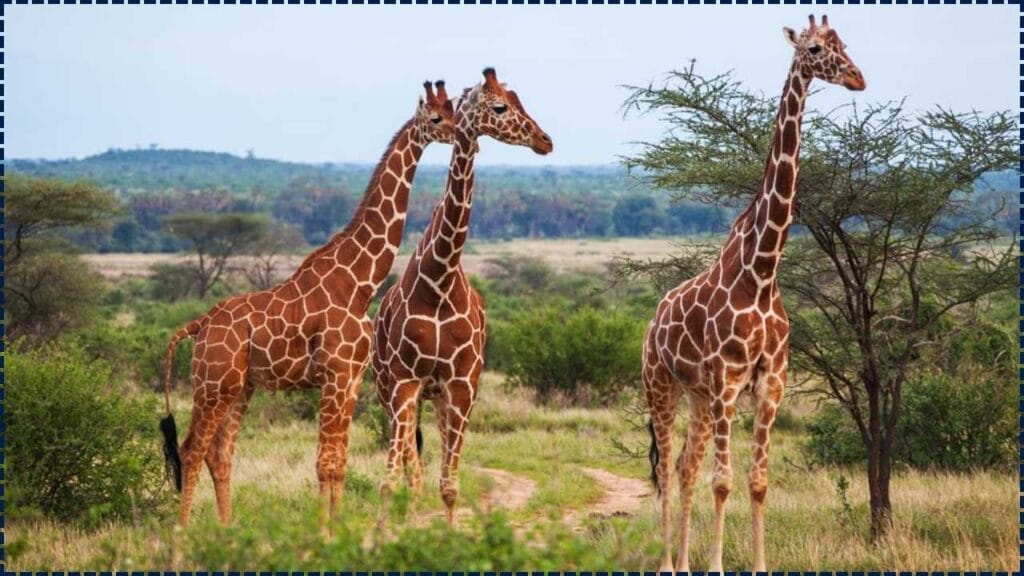Today, we’re embarking on a journey to explore seven of the world’s tallest animals and understand the scientific reasons why their height is so important. These magnificent creatures aren’t just tall for the sake of it; their impressive stature is key to their survival, their ability to thrive, and the way they interact with and shape the ecosystems around them.

These animals aren’t just tall; they are essential components of their ecosystems. Their size gives them unique advantages in finding food, avoiding predators, and interacting with their environment. Understanding their height helps us appreciate the diversity and interconnectedness of life on Earth and reinforces the importance of protecting these magnificent creatures and their habitats for future generations.
Seven of the World’s Tallest Animals
| Animal | Top Height | Why Height Rocks | Science, Roles & Career Paths |
|---|---|---|---|
| Giraffe | Up to 5.8 m (19 ft) (smithsonianmag.com) | Eats treetop leaves, sees predators early, has special cooling system | Cardiovascular biology, wildlife research, conservation |
| African Elephant | ~3.9 m (13 ft shoulder) | Modifies forests, digs waterholes, spreads seeds like “mega-gardener” | Ecology, forestry planning, conservation tech |
| Ostrich | ~2.7 m (9 ft) | Spot threats early, run at 70 km/h | Animal physiology, wildlife management, zoological tourism |
| Moose | ~2.1 m (7 ft) shoulder | Trudges through snow, reaches higher winter browse | Forestry science, cold-environment ecology, veterinary studies |
| Dromedary Camel | ~2.4 m (8 ft) | Stays cool, carries loads across deserts | Animal husbandry, arid-land wildlife management, eco-tourism logistics |
| Polar Bear | ~3 m (10 ft standing) | Hunts ice seals, big for intimidation and charisma | Marine ecology, climate science, wildlife protection |
| Shire Horse | ~2 m+ (6.5 ft) shoulder | Strong partner in farms, calm giant | Equine science, sustainable farming, heritage livestock |
When we look at seven of the world’s tallest animals, we learn a profound lesson: being big often equals survival and purpose in the natural world. From the elegant giraffes who can effortlessly dine on leaves high up in the trees, reaching food no other land animal can, to the magnificent polar bears who use their commanding height to watch over vast ice floes for their next meal, their stature directly supports their lives and helps them thrive.
These incredible creatures—ranging from the “forest architects” who shape their environments to the resilient “arid-land trekkers” who navigate challenging landscapes—serve as powerful reminders of how perfectly adaptation intertwines with deep respect for all living beings. Their unique forms and abilities are a testament to nature’s ingenuity. Understanding why they are so tall helps us appreciate the delicate balance of ecosystems and encourages us.

Why Height Is Such a Big Deal
1. Reaching Food Sony High
- Giraffes are the skyscrapers of the savanna, munching leaves others can’t reach—all due to neck height and vascular genius (time.com, smithsonianmag.com).
- Elephants harness height and trunks to strip bark, prune forests, and shape ecosystems.
2. Predator Awareness & Early Escape
- Ostriches get bird-level vision to see cheetahs before they run—then sprint up to 70 km/h.
- Giraffes glare down from high vantage points to spot lion threats early.
3. Environment & Movement
- Moose stride through deep snow on long legs.
- Camels stay above scorching ground and trek long distances.
- Shire Horses power traditional agriculture with calm strength.
4. Heat & Cold Management
- Giraffes and camels escape heat from tall bodies and wind flow.
- Large-bodied animals like elephants and polar bears store or radiate heat for survival.
5. Ecosystem Shapers
- Elephants dig water holes, spread seeds—earning titles like “mega‑gardener” (sciencedirect.com).
- Moose reshape forest undergrowth far and wide.
Real Science, Real Stories
Giraffe – Circulation Gravity Warrior
They pump blood at 220/180 mmHg at the heart to keep 110/70 at the brain—double our norm—and nature built thick blood vessels, valves, rete mirabile, and strong hearts to handle it.
Elephant – Landscape Architects
Their size and trunks topple trees, carving paths and supporting biodiversity. Elephants maintain forest–savanna mosaics that benefit wildlife and carbon storage.
A Guide for Students and Pros
- Watch & Learn: Dive into documentaries like Planet Earth to see height in action.
- Study the Systems: Explore giraffe heart physiology or elephant limb bone structure via sources like Smithsonian and Nature.
- Understand Conservation Needs: Tall animals need large ranges—study habitat corridors, especially for giraffes and elephants.
- Follow Career Paths: Pursue wildlife biology, ecological restoration, veterinary tech, and field conservation roles.
- Innovate & Engage: Promote respectful ecotourism that supports local and Indigenous communities.
Related Links
You Swore It Was a One-Off—But These 3 Red Flags Say You’ll Spend Again (and Again)
How Long You’d Have To Work To Match Elon Musk’s Fortune — And Why Is It Hard?
Confirmed: Massive “White Gold” Discovery in Nevada Could Reshape America’s Energy Future
Cultural Reflection
In Native tribes, tall beings like cedars or buffalo stand as symbols of guidance and protection. These animals hold similar roles: they hold space in ecosystems and in our hearts, carrying stories that connect us across time.
FAQs
Q: Why does a giraffe’s heart have to beat so hard?
Because it needs to climb blood 6m up to the head—nearly twice human blood pressure—while avoiding puffed-up ankles or brain bleeds .
Q: Do tall animals get more health issues?
Some, like giraffes and moose, experience cardiovascular and joint demands. But nature’s built solid systems for them.
Q: Can shrinking spaces kill tall animals?
Yes—tall species need more room. Habitat loss shrinks food trips and increases predator risk.
Q: Why employ Shire horses today?
They’re eco-friendly heavy lifters—flexible for sustainable farms and historical traditions.








